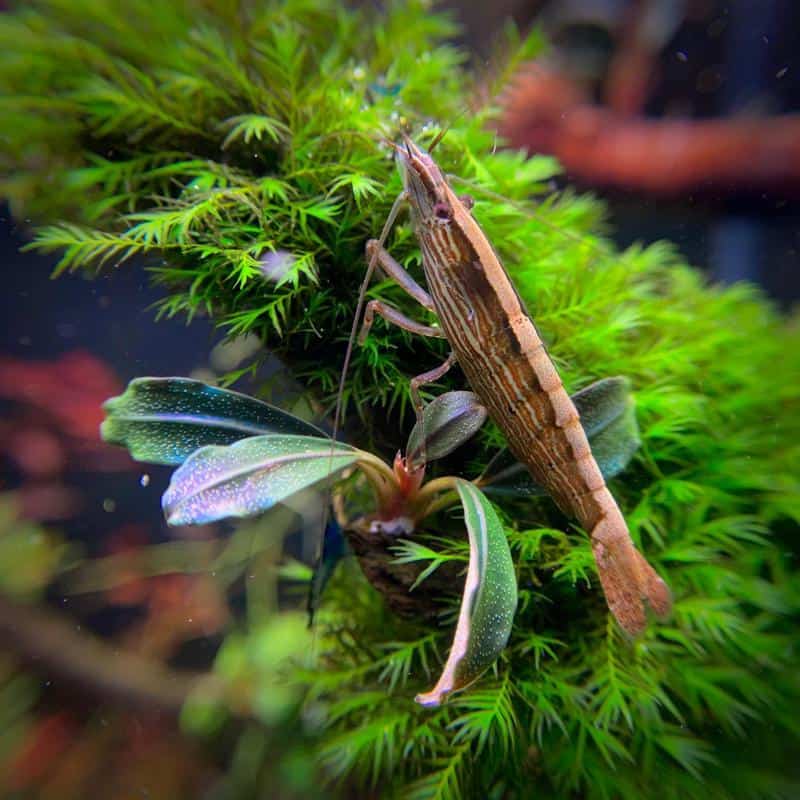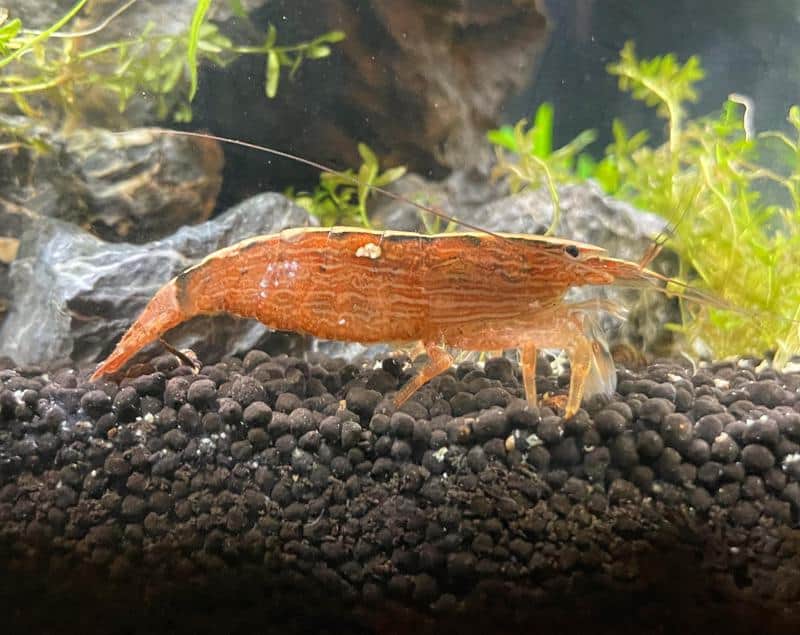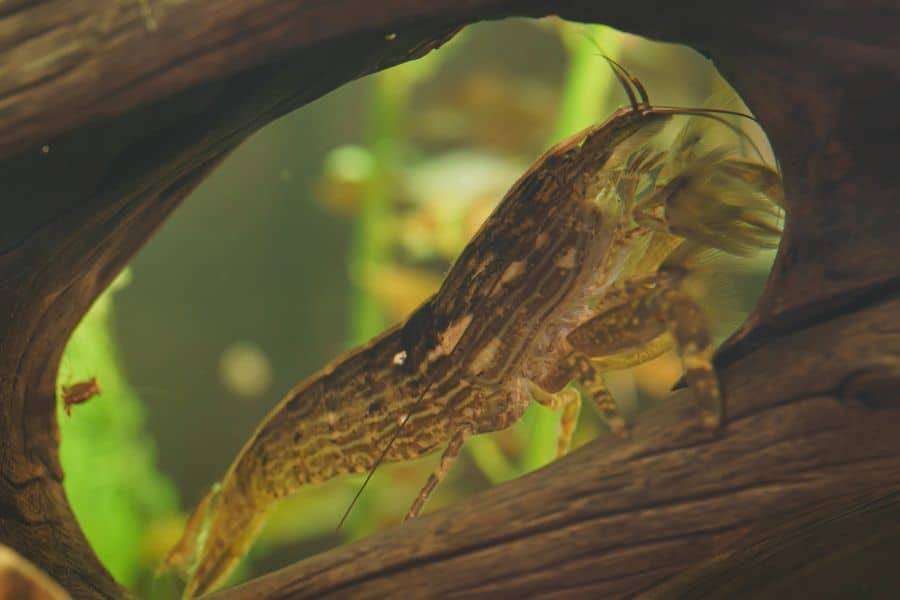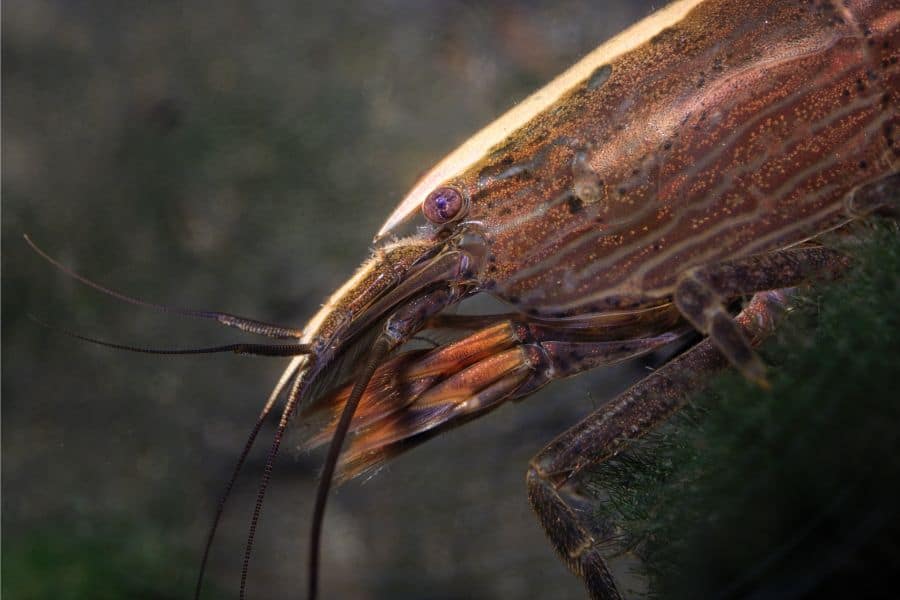Invertebrates are a popular choice among those who want to brighten up their tanks. Small animals like Bamboo Shrimp will surely excel in this part.
They exhibit several unique characteristics that are not found in vertebrates or other shrimp varieties. These species are really easy to care for; therefore, even newbies can easily manage them.
All freshwater creatures require a healthy habitat, so it only takes a little upkeep to keep things running smoothly. Everything you require to take proper care of bamboo shrimp has been provided by us.
We’ll discuss the optimal tank setup, water parameters, tank mates, temperament, care guidelines, and much more.
Bamboo Shrimp Overview
- Scientific name: Atyopsis moluccensis
- Care Level: Easy
- Temperament: Peaceful
- Color: Reddish-brown
- Life expectancy: 1-2 years
- Size: 2-3 inches
- Diet: Omnivore
- Minimum Tank Size: 20 gallons
- Compatibility: Peaceful species
- Temperature: 68-85°F (20-29°C)
- Water pH:0-7.5
- Hardness: 0-10 dKH
Bamboo shrimp are native to Southeastern Asia and are located all across this area. Several countries, like Sri Lanka, Japan, Singapore, Indonesia, Borneo, Sumatra, Guinea, Bangkok, and the Netherlands have extraordinarily high numbers of these freshwater species.
The binomial term for Bamboo shrimp is Atyopsis moluccensis, but it is not a well-known title in the fish trade. Instead, it is also recognized as the Singaporean Flower Shrimp, Wood Shrimp, Fan Shrimp, and Asian Filter Feeding Shrimp.
Many inexperienced fishkeepers mistake them for different freshwater creatures because of their various names, although they are basically the same.
Fast-moving channels and rivers are the native environments of bamboo shrimps. Bamboo shrimp stay firmly attached to stones and plants in order to maintain their stability.
They eat microbes, microalgae, and pathogens that are passed to them by moving water.
Life Expectancy
Bamboo shrimp, like other shrimps, do not survive very long. They can live for a maximum of 1-2 years.
If the aquarium settings are not kept in good shape, the brief life duration is significantly declined. Your pet’s life would be in danger if you don’t take good care of it, just like other freshwater species.
You must take proper care of your shrimp if you want to increase their life duration. Continue to monitor the water parameters and make any necessary water adjustments on a regular basis.
Additionally, before adding additional species or shrimp to the aquarium, examine whether they are infected with any viruses or diseases. If you suspect anything, then it is safer to move them to an isolated tank for recovery.
Appearance
Despite the fact that they don’t have a wide variety of vibrant colors and markings, bamboo shrimp could still have a great contribution to making your home tank look beautiful.
The majority of shrimp have a reddish-brown tint; however, this might vary. Their pigment can occasionally change from green to orange, but this isn’t always a bad sign.
Your shrimp may sometimes look pale; there are a few reasons why this may happen. It might be due to stress which means it will last for a short time.
After they undergo the molting process, they become paler, and this may continue till their fresh shell has formed. A mature Bamboo Shrimp could grow to be around 2-3 inches long.
They have a whitish strip that covers their entire spine. Their shape is similar to the ordinary shrimp that almost all folks are undoubtedly familiar with. A few fascinating aspects should be taken into consideration.
These species have a pair of “fans” that they use to draw food out of their surrounding water. They push them up towards the stream to collect prey and then transfer that into their mouths to consume.
Eyestalks and appendages, which contain the eyeballs and feel the surroundings, are located at the highest point of their skulls. Their stomach may flex because the body has 6 internal parts and a shell. The tail makes up the 6th part.
Males are thin, whereas females have bigger abdomens and broader appendages. Males have a distinct primary set of legs. They use their little, well-developed nails for fertilization.
Size
Bamboo shrimp may reach a size of 3 inches. The most commonly found varieties of tank crustaceans are smaller than these shrimps.
The massive length of bamboo crustaceans benefits them by safeguarding them from attackers. The length of bamboo crustaceans is a significant element while keeping them.
If you house these species in a tiny tank by accident, supposing that they don’t expand a lot, you’ll endanger your pet’s precious life. Therefore, when choosing the ideal aquarium, you should always opt for a bigger size.
Behavior
The bamboo crustacean, as with many other freshwater species, is quite calm and non-aggressive. It coexists peacefully with many other animals and does not exhibit hostile behavior.
It also applies to many crustaceans, fish, crabs, and other creatures. Bamboo shrimp usually like socializing with different species. When engaging in regular routines like eating, they generally form groups.
They don’t seem irritated or even aggressive while they’re together. They are energetic crustaceans who spend most of their time moving around the aquarium.
They prioritize eating; therefore, you’ll typically observe them working on it. A shrimp’s lack of movement and seeming lethargy might potentially be a symptom of sickness or infection.
Molting is also a fascinating trait for shrimp keepers to observe; however, it could be witnessed once a month. A shrimp would first seek shelter before starting to molt.
Once your pet is convinced that it is secure within 1 or 2 days of hibernation, it would molt and come out of its shell. The shell may now be pulled out or kept in the aquarium for other species to consume.
Bamboo Shrimp Care

Everyone could take care of bamboo crustaceans since they need little or no attention. It really comes down to being persistent and providing the healthiest environment possible because there are no special or unusual needs that you have to fulfill.
It is very important to remember that maintaining the water conditions is not difficult, but you must be aware of dramatic shifts. If the water conditions are drastically changed, your pet is more likely to suffer.
To ensure the longevity and health of your pet, it is essential to do periodic inspections and check the aquarium’s environment. In doing so, you’ll be able to see abnormalities before they have a chance to harm your little pet.
Tank Size
A minimum of 20 gallons of space is required for an aquarium to be acceptable for housing just one bamboo shrimp. If you wish to maintain multiple Bamboo shrimps, double the aquarium size so that they can have free space to move around.
Keeping these species in smaller aquariums is possible but not advised. They are way bigger than the standard shrimps.
A bigger aquarium would also make it easier for bamboo shrimp to receive food as they obtain it by filtering freshwater. The ideal aquarium would be one that is longer rather than deep for these species.
A bigger tank provides stronger water currents, which have been beneficial to Bamboo shrimp whenever they are eating.
Tank Condition
Try to fill up your aquarium ground with the substrate. These crustaceans would do great with gravel; however, several tropical species enjoy fine grains, so take that into account while choosing an aquarium.
Cover the substrate with pebbles, decorative objects, and vegetation. Your pet would love to jump over these decors to find a strong water current to get their food.
Plants should be the primary aspect of the aquarium while housing Bamboo Shrimp. Since these creatures are attracted to plenty of plants in their native environment, including those in your tank provides many benefits than just giving them a space to live in.
By incorporating vegetation into their environment, you make it much faster for these animals to obtain food by themselves without depending on their owners or supplements.
Small fragments of plant components would shatter away and fall into the water, which makes it easier for your pet to filter out and eat! These shrimps are also observed to crawl up to the plants.
They feel safe utilizing them as their escape routes in the environment and may benefit from playing with them. These crustaceans won’t really consume the common tank vegetation directly; therefore, you can include any type of plant you like.
A heater is required to keep the environment between 75 and 81 degrees Fahrenheit. The ideal pH range is 7.0 to 7.5. A filtration system is required to maintain the tank clean.
Bamboo Shrimp prefer spongy cleaners since they may rest on them and eat using the pressure from the filtration inflow. There would probably be sufficient water flow across the aquarium due to the filter output.
It might be helped by an air compressor, which would also detoxify the water; however, a water compressor will be unnecessary. It’s safe to use regular aquarium lights.
Water Parameters
It’s necessary to know the suitable water conditions for bamboo shrimp. Despite their toughness and minimal care, constantly changing or poor settings may pose a big danger.
It implies that consistency is nearly as essential as determining the optimal settings.
You must regularly examine these factors in an attempt to preserve this uniformity. It is essential in the beginning while they are getting used to the changing aquarium settings.
- Tank temperature: 70°F to 78°F
- pH levels: 6.5 to 8
- Hardness: 3 to 10 dKH
Possible Health Concerns
The Bamboo Shrimp’s primary health concerns are caused by substantial adjustments to or occurrences in its natural environment.
Among the most prevalent problems seen with this animal is its hypersensitivity to water fluctuations. There is a good possibility that any unexpected changes to the water conditions in their environment would be harmful.
Although it is common for several species, the Bamboo Shrimp could be especially impacted whenever this occurs (but occasionally you’ll be incredibly blessed). We strongly advise you to be cautious while introducing them to your aquarium because of this.
Try to gradually acclimate these animals to their unfamiliar setting by testing the freshwater they are already in. Copper is another concern that may have an influence on the well-being of this animal.
Like other crustaceans, they could be killed by even the tiniest amount of metal in tank water. The fact that copper is included in a great number of aquarium medicines makes it a risk.
Therefore, you run the risk of accidentally poisoning your pet while hoping to save another species in your aquarium. Eliminate these crustaceans before adding a copper-containing medicine to your tank if you find yourself in that position.
Make every effort to replicate the water conditions of their replacement aquarium with their older one. When they’re ready to reintroduce them to their native habitat, ensure that all residues of metal have been completely removed from the tank.
Tank Mates
Bamboo Shrimp have a list of possible tank mates. These animals prefer to stay out of danger and enjoy their time engaging in their favorite activities like eating.
Calm disposition and non-aggressiveness are qualities you should seek in potential tank companions. Any species that is inherently aggressive or considers crustaceans as prey should not be kept together.
We have compiled a short list of species that are the best fit for your pet.
- Cherry Shrimp
- Mystery Snails
- Mottled corydoras
- Black Skirt Tetra
- Otocinclus
- Pygmy Gourami
- Ghost Shrimp
- Spotted nerite
- Amano shrimp
- Dwarf Fire gourami
- Fire Tetra
Do not keep goldfish, Oscars, velvet cichlid, jack Dempseys or any other species that are hostile or likely to attack tiny aquarium occupants.
Diet

Because they are filter feeders, bamboo shrimp don’t require a lot of special food. You don’t need to set aside time especially for feeding them because they simply filter nourishment from the aquarium contents.
Tiny creatures and biological substances, such as algal or plant debris, must be included in the bamboo shrimp diet.
You may either put ground food in their aquarium or treat them with water. It is simple to serve bamboo shrimp by increasing the number of plants and changing the water flow.
They don’t make you seem like you’re abandoning them just like the majority of other freshwater creatures do since they may obtain their own food. You will need to periodically add the feed to the aquarium if the container layout isn’t right for them.
Molting
It’s crucial to be aware that these crustaceans would undergo a molting stage every 45–65 days (roughly). If you don’t know this, you might be surprised by witnessing this.
Since doing it in plain sight will make them ideal targets in nature, they should constantly seek a good hiding location to complete it. When this occurs frequently and you can’t simply locate them, it would get clear that they are undergoing this process.
Although it’s not required, you could detach their exoskeleton if you wish to. It is going to quickly deteriorate and vanish.
Bamboo Shrimp Breeding
Bamboo Shrimp production is an extremely difficult process for such an easy-to-care critter. It’s almost impossible to properly produce them in tanks.
The eggs require seawater for optimum development, which is the main factor for failure. Although it may look like an easy idea to have a second saltwater aquarium for the eggs, other fishkeepers have attempted it (several times).
There haven’t been any reported successful projects; therefore, there are no concrete rules to conduct research.
We advise against even trying to produce bamboo shrimp because of the unusually bad track record. If a knowledgeable producer discovers a way to accomplish it, we’ll be eager to include their advice in this article.
Also Read:
- What Do Aquarium Shrimp Eat?
- How Many Cherry Shrimp Per Gallon?
- Dwarf Freshwater Shrimp: Popular Types & Care
FAQs
How Much Time Can Bamboo Shrimps Stay without Water?
Bamboo crustaceans may barely survive for a few seconds without water. They possess lungs for respiration, which they employ whenever they are not under the water. As a result, it is never advised to remove them from the tank for even seconds, as this might result in their death from anxiety and respiratory problems.
Can You House Several Bamboo Shrimps Together?
Yes, you may maintain many Bamboo shrimp around each other because they are friendly animals who prefer to stay in pairs with their own kind. Since these species are accustomed to staying in colonies in their native environment, they continue to exhibit this behavior when housed in tanks.
Can You Easily Get Bamboo Shrimp?
Yes, bamboo shrimp are widely accessible since they are well-liked creatures in tanks. They are simple to get on the internet or at your neighborhood shop.
Conclusion
Bamboo shrimp are intriguing to both professional fishkeepers and newbie enthusiasts. Their fascinating filter-feeding trait offers unlimited fun, and their stunning appearance is only enhanced by their remarkable colors.
They’re ideal for both social and individual tanks, which is a plus point for all the fish keepers. You can easily maintain them if their tank conditions and environment are optimal.

